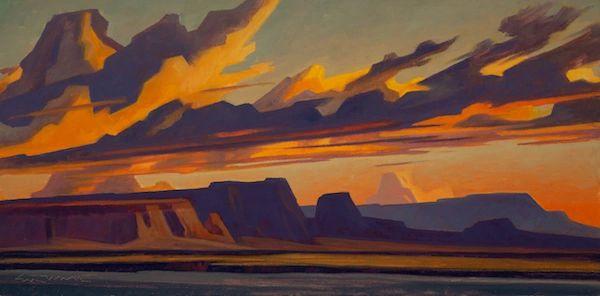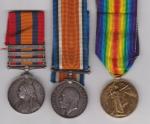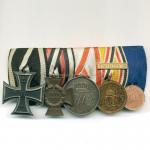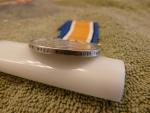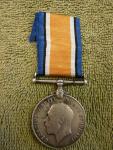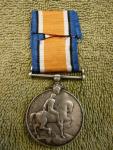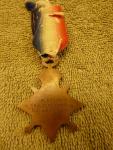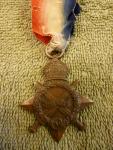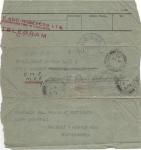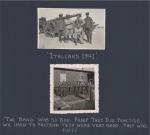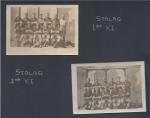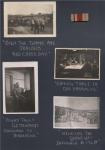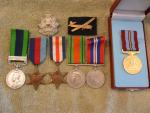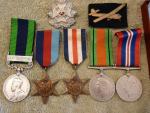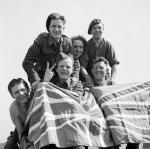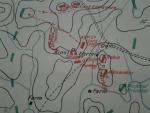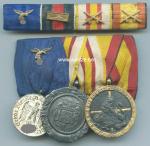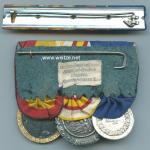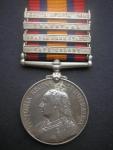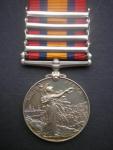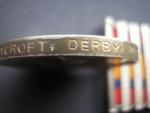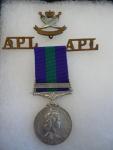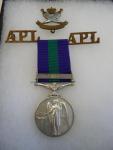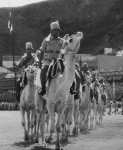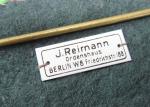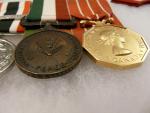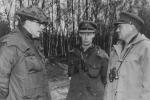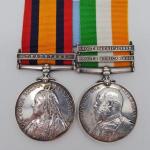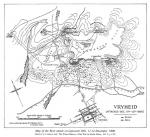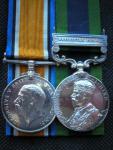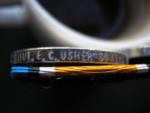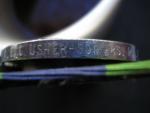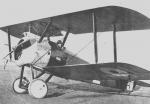-
Posts
1,802 -
Joined
-
Last visited
-
Days Won
10
Content Type
Profiles
Forums
Blogs
Gallery
Events
Store
Everything posted by azyeoman
-
Medal group of two: Guelphic Medal for Bravery 1815 with original silver suspender (CORP ... KOHNE, FELD BATAILL .... BREMEN), Hannover Waterloo 1815 with replacement silver clip and straight bar suspender (CORPORAL ...NRICH KOHNE, GRENADIER BAT. BREMEN). Two translations of his citation are available:- Citation from von Wissel: Soldat Koehne, Feldbatallion Bremen. 17th June. Distinguished himself with such conspicuous bravery in a skirmish battle that he was immediately promoted-in-the-field to Corporal. 17 June (1815) Soldier Kohne distinguished himself so obviously as a Tiralleur that he was promoted on the spot to Corporal. Only four Guelphic Medals were awarded to Feld Batallion Bremen, of which two were returned. The battalion took 62 casualties at Quatre Bras on the 16th June and a further 239 at Waterloo on 18 June. Contact marks and heavy edge bruises including some wear to naming. (F)
-
Yet another Boer War PoW group with very interesting possible historical connections: QSA with three clasps: NATAL OFS TRANS officially named to: 109 TPR H BRIDGEWATER BETHUNES MTD INFY WWI BWM & Victory 2 LIEUT H BRIDGEWATER RFA; later he was a lieutenant in the R.A.F. Confirmed on the nominal roll: Bridgewater H 109 E Trooper 19/10/1899 14/08/1900 Hotel de l'Europe Heidelberg, Germany Dis O R Bridgewater was captured on 23/1/1900 and was released on 6/6/1900. Before WWI, Howard Bridgewater was Asst. Mgr. of the FINANCIAL TIMES newspaper. Bethune's Mounted Rifles was an irregular British South African Unit. Some unable to enlist in any of the official contingents, rushed to South Africa to join any unit they could find. There were many. Bethune's was one such unit and it included Americans, Scandinavians and Australians. For information on Bethune's Mounted Infantry, please visit: www.angloboerwar.com/unit-information/so...nes-mounted-infantry
-
Thank you very much! What a surprise; especially when there are so many amazing scholars and authors on this site. I sincerely appreciate the award and hope that all of the posts I've made over the years have helped some historian, descendent or relative or some collector to further his knowledge and interest in the area discussed. Each and every individual who was awareded a medal has a story and all of them should be appreciated it. Thank you again and all the best to all of you for all the wonderful knowledge and insight I've gained from you. I hope you look forward to reading about PoWs as much as I look forward to reading about your areas of interest and expertise.
-
Dr. Mark Connelly, a Reader in Modern British History at the University of Kent, wrote an excellent article for the Journal of the Centre of First World War Studies. The British Campaign in Aden, 1914-1918 Mark Connelly The intention of this article is to show that the lessons gathered during a century of colonial warfare and policing were applicable to certain campaigns during the Great War. The attention given to the battles fought on the Western Front has tended to overshadow British, Dominion and imperial activities in other theatres, and therefore tends to create the impression that this vast conflict proved all previous experience at best only partially useful in modern, industrialised warfare. As this piece will make clear, the principles of colonial warfare, as codified in 1896 by C.E. Callwell in Small Wars. Their Principles and Practice, were relevant in a global conflict that otherwise revolutionised, or made redundant, so much of pre-existing British military practice. The campaign in Aden also provides an interesting insight into the nature of the British Empire during the Great War, particularly the position of native troops within the Indian Army, and the application of new technologies for traditional British imperial purposes.1 Originally occupied in 1839, by 1914 Aden was of vital importance to Britains worldwide empire. The territorys strategic importance and value lay in its geographical position at the junction of the Red Sea and the Aden Gulf. It was a significant nodal point allowing access to the African and Arabian coasts and into the Indian Ocean. The vast expansion of the British Empire during the nineteenth century, the advent of steam shipping, which created a need for strategically placed coaling stations, and the opening of the Suez Canal made Aden a lynchpin in British communications. Although Adens security was therefore of great concern to the British, the political mechanisms for its governance were far from satisfactory. R.J. Gavin, historian of British Aden, was unequivocal in his condemnation and claimed that its whole history since 1839... [was] marked by administrative confusion and complication.2 In 1914 a Political Resident, usually the commander of the British military detachment, who was answerable to the Government of Bombay, and thence to the Government of India, administered the territory.3 It was thus a fairly laborious command structure, but the combination of civil and military powers in a soldier was a common practice in the empire. From the 1870s the Political Resident had been forced to maintain an awareness of Turkish ambitions in the area. The Turks had invaded the Yemen in 1872, which brought them close to the somewhat ill defined edge of British territory. Negotiations over the border were conducted between 1902 and 1904 resulting in a general, if slightly loose, agreement.4 In terms of geography and climate Aden was far from welcoming to Europeans. Soaring mid-summer temperatures provided the greatest problems, which then gave way to sudden spells of cold weather in the winter and spring. Balancing this intense problem slightly was the low risk of tropical diseases due to the absence of vegetation, and the relative purity of the drinking water. Three steam condensers had been installed at Steamer Point, and wells and an aqueduct had been built to bring water from the hinterland. However, the wells and aqueduct supplies were declared suitable for Arabs, Somalis and animals only. The centre of the territory was the port of Aden itself and its protecting peninsula, Steamer Point: twenty-one square miles in total. Fanning out behind was the desert which rose upwards gradually to the settlement of Sheikh Othman,5 the key position in the hinterland as it was the head from which Adens water supplies flowed. Beyond this Wadi Tiban ran up to the Yemen frontier, and on its eastern banks were the settlements of Waht and Lahej, governed by an Arab bound by treaty to Britain, as, in theory at least, were the leaders of all other Arabian groupings up to Muscat on the Persian Gulf. Communications from the port to these outlying points was by road and then track.6 The most remote of Adens territories was the island of Perim lying 100 miles west of the port. It forms a road block in the southern entrance to the Red Sea and was therefore of considerable strategic importance. Menacing this British outpost was a Turkish garrison just across the narrow strait at Sheikh Said in the Yemen. Adens significance in Britains maritime and cable communications with the empire was not matched by a particularly impressive defence commitment. In August 1914 it consisted of only two battalions, one British and the other Indian, lacking field or mountain artillery, and one cavalry troop barely 100 strong under the command of the Political Resident. British troops generally spent only one year on garrison duty as the final assignment of an Indian tour.7 Few soldiers enjoyed their service in the arsehole of the empire, so-called because everything went through it.8 Numbers appeared to support the Turks for they had an army corps just over the board in the Yemen. However, the exact number and condition of these troops and their supporting logistical infrastructure were unknown. The only hard evidence available was that provided by Sir R.E. Solly Flood. Visiting the Yemen as part of the British team negotiating a border settlement in 1905, he inspected Turkish troops and was suitably impressed by their quality and demeanour.9 Defending Aden against the Turks therefore demanded a dual approach. On the surface it was a colonial warfare scenario due to the reasons sketched out above: any potential military operations would have to be carried out in an environment lacking a full, modern, westernised infrastructure; the potential enemy was a rather shadowy and mysterious force necessitating a careful intelligence-gathering programme, and the outcome of any clash with the enemy would have wider psychological and physical affects on the native peoples relating intimately to Britains prestige and influence in the region. This seemingly tricky combination of factors was, however, not unfamiliar to the British and had been faced many times before in the previous century. However, on the flip side it was a modern combat putting British and Colonial troops against an army trained, organised and equipped along European lines. Britain and Turkey rather drifted into war in November 1914 following a round of confusing diplomatic manoeuvring.10 The opening of hostilities threw the defence of Aden into chaos for the 1/Royal Irish Rifles guarding the territory were recalled to Britain thus denuding the Proctorate of cover Aden. Reading between the lines of the Aden Force General Staff War Diaries, it appears that a detachment of troops was cobbled together and despatched from India including the a detachment of the 1/Lancashire Fusiliers were moved from Karachi as a stop-gap measure.11 Sir John Maxwell, Commander-in-Chief, Egypt, then earmarked Major-General Sir George Younghusband's 28 (Frontier Force) Brigade for the Procterate, but did not release it immediately.12 Anxious to ensure free movement in the southern end of the Red Sea, the initial task of the Aden forces was the defence of Perim and the deterrence of the Turks at Sheikh Said. Warned to be vigilant on 29 October, the OC Perim reported on 1 November that the Turks were not engaged in any unusual activities. Seizing the opportunity this represented, he therefore ordered the evacuation of all European women from the island on the following day. Over the next week he maintained a close watch on the Turkish positions as a new camp was established some four miles from Sheikh Said, and studied the potential for a landing.13 On 10 November troops of the 29 Indian Brigade, en route for Suez, were diverted to Sheikh Said and effected a landing. Although few Turks appear to have been killed or captured, a large quantity of military materials were seized and emplacements destroyed, which was probably of more significance given the logistical obstacles standing in the way of rapid replacement.14 Having scored this success, Lieutenant-Colonel Jacobs, the Acting Resident, signalled to ask whether he should make arrangements to despatch a column and begin arming the Arabs of the interior.15 Such plans were typical of British colonial rule and warfare, and as such reveals the underlying conception of the situation. Major-General D.L.B. Shaw arrived on 26 November replacing Jacobs as Resident, and proceeded to make formal contact with the Arabs.16 In January 1915 a British officer was despatched to Lahej in order to teach the Sultans men how to use the four field guns presented to him.17 At much the same time negotiations were opened with Idrisi of Sabia, a significant potentate in Western Arabia. Encouraged by the disruption Idrisi could inflict on Turkish rule in southwestern Arabia Shaw urged Delhi to agree a treaty. Eventually agreement was given and Idrisi was supplied with an initial consignment of 150,000 rounds of ammunition and 25,000 rupees. A few months later this was supplemented with a 200 rifles, 3,000 additional rounds, and a sale of a further 250,000 rounds was authorised.18 Thus Shaw fell into line with British policy across Arabia: the support of Arab insurrection against Turkish rule. In Aden itself more obvious measures were taken to protect the territory. A month before war broke out work commenced on improving the ports defences. Searchlights were placed on the Elephants Back ridge, and all shipping was warned to signal clearly or risk fire from the shore batteries.19 The undermanned Royal Engineers detachment then laboured hard to improve the water condensers, an absolutely vital pre-requisite for the defence of the territory, while also extending the refrigeration plants and signalling and communications in the harbour area.20 On the 26 November the first detachment of men from the 4/South Wales Borderers (Brecknockshire battalion), sent to replace the 1/Royal Irish Rifles, arrived. These sketchily trained Territorials were now the sole all- European force in Aden.21 A training programme was commenced in January, and a month later they were deemed capable of manning the harbour defences.22 Further security was given to allied shipping by the completion of new redoubts on Perim by the 23/Sikh Pioneers, and the seizing of Kamaran Island by the 108/(Indian) Infantry some 200 miles north of Perim.23 It can therefore be seen that the greatest attention was paid to the port itself, and little notice was taken of the hinterland, and the vital position of Sheikh Othman in particular, although the Royal Engineers did manage to lay telegraph and telephone lines to Sheikh Othman and Lahej. Shaw probably believed that the treaty with the Sultan of Lahej ensured the safety of Adens backdoor. However, with only a scratch staff and few advisers with any real experience of Aden or its peoples, Shaw was not working from a basis of hard knowledge. The intelligence reports that started to flow in from these new allies were at best patchy, and should have served as a warning. Soon after the raid on Sheikh Said an Arab informer had stated that 20,000 Turks were on the move with the intention of taking Perim; as the Staff assessment wryly noted, probably 200! 24 A month later the Commanding Officer of the 109/(Indian) Infantry on Perim was told that 3,500 hostile Arabs were planning a crossing. He demanded verification of these reports, which revealed them to be false.25 In the meantime a Turkish force was being assembled in the Yemen, and the British failure to undertake a more active policy was discouraging the local Arabs.26 Shaws ability to demonstrate Britains military might was compromised by the scale of the duties his small number of troops had to undertake. The 109/Infantry was divided between Perim, Kamaran and the mainland; the 23/Sikh Pioneers were also divided, half as a garrison on Perim, and the other in Aden. In addition, both the 23/Sikh Pioneers and 126/Baluchistans were detaching drafts for Indian units in France, while the Brecknocks were still learning their trade and had not yet experienced an Aden summer. Artillery was also a problem, as many of the field guns brought by the 28 Indian Brigade had been transported to the island garrisons. More troops had been promised, but there were few guarantees. Aden was hardly protected by a concentrated force with a sharp cutting edge. Matters were confused still further by a brief outbreak of ill discipline among certain Indian troops. In 1913 exiled Indian nationalists had started a newspaper, Ghadr (Mutiny), with the aim of promoting non-sectarian opposition to British rule. With the outbreak of war planning commenced for a rising of Indian soldiers. British counter-intelligence managed to ascertain enough details to arrest certain key figures and investigate the conspiracy. Despite this action, some disturbances followed in February 1915 in Rangoon, and then in Singapore, but it took until May for trouble to boil over in Aden.27 The Procterates mail censor had consistently removed all copies of Ghadr from shipping passing through the port making it hard to determine whether the actions were connected directly with the plotters.28 However, some kind of conspiracy does appear likely for violence broke out in two different units within days. Eight sepoys of the 126/(Indian) Infantry ran riot and shot at their officers, and three sepoys of the 23/Sikh Pioneers attacked two-subadars. All who took part were swiftly arrested, and there is no evidence to suggest a general break down of discipline in these units. The records do not imply any lingering suspicion of these battalions and there were no further acts of ill discipline.29 These disturbances may well have deflected attention at a crucial moment for the Turks were on the verge of launching their most serious assault on Aden. In mid June an attack was made on Perim. Twelve dhows were spotted in the strait and the garrison opened fire, only three men got ashore and the attack was comprehensively beaten off. Somewhat mysteriously, and perhaps hinting that there were still some Indian malcontents, the garrison commander reported that the action was conducted without telephonic communication as the equipment had been deliberately damaged.30 Around the same time reports began to filter in that the Turks were preparing to advance on Lahej. The Lahej detachments of the 109/Infantry and the Aden troop took these seriously enough and advanced with the intention of conducting reconnaissance missions.31 At first Shaw and Jacobs treated these reports with suspicion, probably because the accuracy of all earlier information had been so erratic. On 29 June matters escalated as Jacobs was informed that the Turks were indeed advancing and that the Haushabi peoples in the hinterland around Lahej had no intention of resisting them. Over the next few days the situation became even worse. It was reported that not a single friendly Arab intended doing anything to defend Lahej. Prince Mohsin is discussing going over to the Turks as he states merely as a trick.32 Shaw and Jacobs strategy was thus fatally undermined, and they had to order the despatch of a Movable Column. Columns, whether flying or firmly attached to their communications, were a standard part of British military procedure in colonial campaigning, but this effort collapsed almost entirely. Scrabbling round for troops, transports and equipment, Shaw and Jacob despatched the Brecknocks to lead the force on 10 July. Untried and inexperienced, these men were ordered to march in the soaring July temperatures of well over 100 centigrade. Within a short space of time the column was in desperate trouble affecting the Indians of the 126/Baluchistans as well as the Europeans. Jacob requested information and provided advice, but it was offered far too late: Am personally much concerned over the progress of the column. The march will be most trying in this heat. It is absolutely necessary that the troops and transport be kept well in hand and not urged beyond their powers especially the British Territorial unit. This should not be taken further than 1⁄2 way if they cannot stand the great heat.33 Jacobs and a staff officer went forward in order to ascertain the situation. They found the column in chaos and witnessed Brecknockshire men collapsing by the roadside. The men had not got much further than Sheikh Othman and none appeared to have reached Lahej.34 Men of the 126/Infantry grabbed their bridles and would not let them pass stating that Turks were already through Lahej. Officers were trying to impose some semblance of order by directing the Baluchis and Brecknocks to collecting points at the gun positions. Most were in an appalling state suffering from heat exhaustion and dehydration. The column had gone off before the Lines of Communication medical services could get into their forward positions, and the supply camels and their drivers went missing meaning that dumps of medical supplies and water had not been completed. It was only at 5 p.m. that the forward medical services could offer any kind of assistance.35 Lack of transport, food and water entirely prevented any chance of moving forward without them considering the state of the troops who were absolutely exhausted.36 At Lahej the rest of its available manpower reinforced the detachment of the 109/Infantry including a flying guard consisting of one section and machine guns in cars. The total force was still not very strong, no more than approximately twenty officers and about four hundred men. Positions were selected on the road leading north out of Lahej reinforced by a machine gun, and east was covered by a machine gun manned by the 23/Sikh Pioneers and two ten-pounder field guns. Manpower had been thinned still further by the desertion of the Abdali gunners, although a hundred Abdali had been rounded up and ordered to posts north of the town. The Turks came on in strength in the late afternoon and soon began to push through the thin cordon. Gradually, the men of the 109/Infantry and 23/Sikhs fell back rallying on the stoutly built Guest House before commencing a withdrawal. As they fell back they gained contact with the shattered column adding to the logistical disaster, as the wells were now giving out. Jacobs was left with little option other than to attempt to retreat with some degree of order and discipline. Intending to rally the men at Sheikh Othman, Jacobs was thwarted by shambolic logistics, and the utterly demoralised state of the Brecknockshire men. The new positions lacked shade, and, although some food and water had been brought up, many men died of heat apoplexy.37 With no transport to provide communications to the port, Jacob took the decision to abandon Sheikh Othman and with it the main natural water supply.38 The disaster that befell the column quickly impressed itself on the troops stationed in the port. The rapid collapse of communications must have had an unsettling effect reflected in the laconic, but anxious, statement in the Royal Engineers war diary of 5 July: No information alarmist reports. Cases of heatstroke brought in on cars.39 A stream of men was soon trickling back to the hospital. Sixteen cases of heatstroke were admitted on 4 July, twenty-four on 5, fifty-six on the 6, and twenty- two on the 7. Wounds caused by enemy action were, by contrast, very small, no more than about fifty.40 The Brecknocks were a broken force with ninety-four men in hospital and the remainder declared fit for garrison work only.41 On 10 July, Colonel H.F. Cleveland, Indian Medical Service, and Assistant Director Medical Services, took the opportunity to examine the Brecknockshire mens headgear. He declared them quite unserviceable... [as they] afford practically no protection from the sun, and demanded their replacement with Cawnpore Topis.42 Clevelands judgement is damning, but the reasons why this problem had not been noted and resolved much earlier are not provided. Fortunately, and somewhat mystifyingly, the Turks never attempted to exploit their success. Unaware of the Turks lack of ambition, frantic efforts were made to redress the balance. The 9/Gurkhas on the troopship Teesta, bound for Suez, had just arrived in Aden harbour and so were rapidly disembarked, as were the Australian Light Horse.43 Another timely arrival also served to alleviate the situation. On 8 July Major- General Sir George Younghusband arrived with half the 108/Infantry, the first detachment of the long hoped-for reinforcements. Younghusband hurried ashore and replaced Shaw and Jacobs immediately. Brigadier- General Price, en route with the 28/(Frontier Force) Brigade and two Territorial Horse Artillery batteries, was Jacobs eventual successor, while Shaw was ordered to Karachi.44 Effectively, both had been stellenbosched. Although it could be argued that both men had been made scapegoats for the Government of Indias failure to provide the requisite manpower and resources to defend the Procterate, it should also be noted that they singularly failed to establish any kind of infrastructure to support their strategy. Both Shaw and Jacobs were experienced Indian Army officers who should have understood some of the basic principles of this kind of warfare. The deployment of a column demanded some understanding of its communications and yet nothing was done to improve the road to Sheikh Othman or its defences. When the Movable Column was despatched it left hurriedly in an improvised reaction rather than as part of a carefully prepared plan. The decision to commit the Brecknocks also looks suspect in hindsight. As Indian Army officers they should have realised the potential impact of the Arabian summer sun on troops recently arrived from England; however, this may well have been the result of two closely interwoven factors. First, the recent outbursts of ill discipline among Indian troops may well have made it appear both militarily sensible and politic to include a body of white troops on the mission. Secondly, to leave a large body of white troops on harbour defence duties when black soldiers were being marched into a combat zone might have run the risk of undermining concepts of white moral and physical supremacy. Assessing the situation with remarkable speed and clarity, Younghusband devised a new strategy. On 16 July, he informed Delhi that he intended to retake Sheikh Othman as soon as possible. His decision was most probably driven by the water situation. He reported that Aden was calm, the troops, aside from the Brecknocks, gave no cause for concern and he was confident of taking Sheikh Othman after which he intended to fortify it. Lahej, however, was a different matter. Younghusband estimated that two full brigades were required to recapture and hold it.45 At 3 a.m. on 21 July he commenced his advance. The leading troops were soon through Sheikh Othman, and the 51/Sikhs easily beat off a desultory Turkish counter-attack. The Turks appeared to be caught utterly unawares. Intending to pursue the fleeing enemy, the Aden troop was unleashed. They galloped off with great gusto and scattered the Turkish rearguards, but the heat and the heavy going resulted in the abandonment of the pursuit. Within twenty-four hours repairs to the water supply were completed and water was flowing into Aden. 46 Realising that due to massive overstretch the Government of India was highly unlikely to find more troops for Aden Younghusband recommended that it be turned over to the strategic defence. The fall of Sheikh Othman had re-established the water supply and for as long as it was held strongly and its defences maintained the port was in little danger. Acting on his advice, the Government of India declared the main tasks of the forces at Aden to be the defence of the port, its water supplies and the wireless station. Lest the defence became too inert, it was agreed that a Movable Column should be formed to ensure a regular supply of information and punish any Turkish moves from Lahej. His job completed, Younghusband passed on his duties as Resident to Price and departed.47 In essence the task was now one of frontier enforcement, albeit a complex one demanding the defence of a port, and co-operation with the Navy, but it was something the British had been doing for a long time. Unlike Shaw and Jacobs who mystifyingly failed to apply the lessons of frontier warfare, Price, who had already served in Aden, commenced an impressive programme of works to create the infrastructure required to maintain an active defence. The 109/Infantry spent much of October, November and December entrenching around Sheikh Othman, and monitoring Turkish movements.48 Almost incredibly, a full survey of the Procterate had never been undertaken. The Royal Engineers were therefore requested to provide a full map with special attention paid to the region north of Sheikh Othman. Reacting with vigour the CRE (Commander, Royal Engineers) requested permission to lay down a light railway from the port to Sheikh Othman with the intention of extending it to Lahej once it was back in British hands. In co-operation with the CRA (Commander, Royal Artillery) new telephone lines were established between the gun lines at Sheikh Othman and the port, which had relied on borrowed equipment for visual signalling until this point, and the newly arrived 4/Buffs, replacing the thoroughly exhausted Brecknocks, were trained in the use of field telephones. By December work was completed on the new railway providing an efficient way to move troops and equipment to the Sheikh Othman defences. Early in the new year engineering operations were completed with the construction of a new water condensing plant at Sheikh Othman which was then connected to the high level tanks at Steamer Point in the harbour, and the sinking of a deep tube linking the two points. Price was clearly determined that the garrisons water supply was never again imperilled.49 Additional works were also carried out at Perim where the fort and water condensers were improved.50 Good intelligence was now required to ensure the safety of the Procterate. On Kamaran close connections were forged with the local traders and fishermen in order to keep track of Turkish movements on the coast.51 In January 1916, a full appreciation of Turkish forces in the Lahej area was completed. It was believed that the force consisted of some 4,000 Turks, 600 Arabs, nineteen guns, and seven machine guns.52 At this point the opposing forces were relatively even for the Movable Column war diary gives the Sheikh Othman garrison as 500 British troops and 3,000 Indian.53 However, it did not interfere greatly with the overall strategy, which remained in a defensive mode. This thinking dominated all subsequent decision-making. When the commander of the Kamaran garrison requested permission to attack Salif in conjunction with the local Arab leader in February 1916 it was firmly refused.54 A week or so later rumours of a Turkish surrender and withdrawal spread. Price took the opportunity to signal Simla and ask what policy should be enacted in the event of a Turkish retirement. The reply was cautious in the extreme. It ordered Price to avoid any entanglement with the Turks and concluded, This policy is to be adhered to.55 Hopes of returning to more active operations were raised in the summer of 1916 when the Arab revolt broke out. These were increased by the belief that the campaign in East African was on the verge of a successful completion, which would free troops for Aden. Major-General J.M. Stewart, who had replaced the sick Price, requested an additional brigade and at least twelve field guns. However, neither the Arab revolt nor the East African campaign sufficiently met expectations to alter the situation in Aden, and so the policy of active defence designed to hold down as many enemy with as small a commitment as possible remained unchanged.56 Expectations were raised again in the autumn of 1917 as the campaigns in Mesopotamia and Palestine swung towards the allies, but once again it did not result in the release and redeployment of scarce resources.57 Anxious to ensure that the morale and fighting spirit of the men were maintained, both Price and Steward engaged in a host of minor actions between the autumn of 1915 and the end of the war that were ideally suited to an army used to rapid deployments and manoeuvres.58 In September 1915 the 62/Punjabis and 4/Buffs advanced from Sheikh Othman and engaged the Turks at Assela and Waht. A short, sharp action followed in which an early British advantage was reversed when the Turks brought down shrapnel fire. The column retreated to Sheikh Othman and successfully beat off the pursuers.59 The flying column went out again in January 1916 meeting the Turks at Hatum. Again early British successes were not sustained and the Turks successfully counter attacked. However, the column clearly acted with discipline and efficiency as the Turks sustained some 200 casualties whereas British losses were under fifty.60 Active patrolling went on throughout the spring with the flying column making almost daily excursions from Sheikh Othman in April and May. From June the pace slackened due to the summer heat. During this period a presence was maintained with regular patrols from the Aden Troop, and it is clear from the war diary of the 26/King Georges Own Light Cavalry that the men engaged carried out these tasks with a great deal of enthusiasm and intelligence following and investigating every movement and development.61 Large-scale manoeuvres were resumed in the winter, and in December the column cleared Jabir and Hatum, which resulted in the withdrawal of Turkish forces in the area to the defences of Lahej.62 The pattern for the rest of the conflict had been established of winter and spring skirmishing followed by a lessening of activities in the blistering heat of summer.63 In the meantime, work continued on improving communications in the expectations of launching major operations. The railway network was extended and a new road was laid to Robat.64 British firepower had been increased by the arrival of fresh artillery with Younghusbands brigade. The few guns available to Shaw and Jacobs were largely immobile due to a lack of draft and pack animals. Price altered this scenario with the railway, the arrival of more animals, and, crucially, the fitting of sand tyres in October 1915. This increase in transport and logistical potential allowed the guns to support operations much more effectively. On 12 January 1916, 1,138 rounds were fired, easily the greatest number of the campaign in any one day, but unthinkable before the light railway.65 However, the mobile artillery was not powerful enough to inflict real damage on the Turkish forces or engage in effective counter-battery work. To a certain extent the application of new technologies made up for this deficiency, and provided a signpost towards future imperial policing operations. Within days of the disaster at Lahej, Shaw had requested the assistance of an aeroplane or a seaplane to assist in the defence of Aden.66 The request was accepted in 1916, but it was not until June 1917 that the seaplane carrier HMS Raven II arrived, and its aircraft were then used to bomb Turkish positions.67 A not inconsiderable motive behind these operations was the perceived effect on Arab opinion. The awing spectacle of aerial bombardment made up for the blow inflicted on British prestige incurred by the retreat from Lahej and the inability to recapture it.68 In this respect, technology was the maiden of traditional British concerns and codes of warfare, not the precursor of a new departure. In fact, in strictly military terms, the effect of bombing was mixed. It was reported that: The aeroplanes have driven the Turks to ground... [but] it is difficult to draw them into any action without pushing home the attack; they offer no targets to the artillery.69 This was the lesson of the Western Front: when taking on an entrenched and determined enemy armed with modern weapons artillery supremacy was vital. Somewhat ironically given this stalemate and reluctance to take action matters escalated when the Armistice was declared. The Turkish commanders in the Yemen were reluctant to surrender and disarm, and the British suspected that the Imam of Yemen was colluding in these manoeuvres fearful that the Turks would evacuate before settling their debts.70 Lacking troops due to Spanish Influenza, the British were incapable of forcing Turkish compliance and so maintained negotiations until early December. A final demand was issued and a detachment of Turkish troops surrendered formally on 6 December. British patience was running down and so troops of the 2 101/Grenadiers were despatched from Egypt. Arriving off the coast of Hodeida on 13 December they demanded the surrender of the garrison, which was ignored. The Grenadiers landed on the following morning and advanced from the north. A combined force of Turks and Arabs opened fire as the Grenadiers fought from house to house during the course of which the Indians suffered one killed and one wounded.71 Stalemate reigned and continued even after the arrival of the 7/Rajputs as the British proved reluctant to force the still recalcitrant Turks any further. A march on Lahej was combined with the landings at Hodeida, which resulted in the disarming of 2,500 Turks. But, even this did not result in a neat resolution for elsewhere, including Hodeida, the Turks surrendered only in batches. The task of evacuating the Turkish garrisons was not completed until March 1919 by which time a further 4,100 men had surrendered. Only at this point could the demobilisation of the Aden Field Force commence.72 Maintaining a force capable of diverting the Turks between 1915 and 1918 was a demanding task due to the enervating climate and nature of Aden. Sickness and the heat were responsible for a higher attrition rate than the Turks. After the engagement at Waht in September 1915 the 4/Buffs suffered eight fatalities six of which were due to heat exhaustion. The battalion war diary remarked: The whole battalion suffered greatly from the heat of the sun and sand... The distance covered was between 20 and 23 miles.73 Between the battalions arrival on 4 August 1915 and its departure on 30 January 1916 it incurred six casualties due to enemy action, but over 200 from sickness including nearly 100 men invalided home to Britain.74 Troops arriving in Aden often went down with sickness within a short period shocked by the fierce environment. A detachment of gunners sent to replace the men of the 4/Hampshire battery in June 1916 were declared unfit for service in Aden.75 Within days of arriving from Penang the Malay States Mountain Battery was stricken with diarrhoea and dysentery.76 Lieutenant-Colonel Baldock of the 108/Infantry died as a result of dysentery on 19 October after a fever lasting three days.77 A mysterious fever also struck down many men of the 4/Buffs. Attempts were made to identify the parasite responsible but no firm conclusions were reached.78 Returning to the harbour after a short period manning the Sheikh Othman defences 145 4/Buffs officers and OR were confined to hospital.79 A few weeks later the commandant of the British Base Hospital decided to inspect the entire battalion.80 Working hard to fight the instances of disease, the ADMS (Assistant Director Medical Services) expressed concerns about the purity of drinking water and inspected the latrine arrangements at Sheikh Othman.81 Scurvy broke out among the Indian troops in November 1915 resulting in the distribution of limejuice and tins of jam.82 Indian troops also experienced a clutch of Venereal Disease cases probably contracted from prostitutes in the Aden bazaar. In a move emphasising the misogynist military medicine of the period, the ADMS promptly recommended the deportation of all women found carrying the infection.83 From September 1918 Spanish Influenza spread with appalling speed. By November the flying column was practically immobile from influenza with 175 deaths and over 2,600 cases.84 This high attrition rate led to the regular rotation of British battalions. The 4/Buffs replaced by the Brecknocks in August 1915 and were themselves relieved in January 1916 by the 4/DCLI who remained until February 1917. At this point the 6/East Surreys took over remaining until January 1918 when they were replaced by the 7/Hampshires. The Frontier Force brigade was downscaled from January 1916, but Indian units generally served for longer periods probably because they were deemed better able to cope with the harsh climate. The 108/Infantry and 126/Baluchis served from 1914 until January 1916, but the 109/Infantry were not relieved until October 1917. The Malay States Guides arrived in October 1915, the 75/Carnatics in January 1916, and both remained in Aden until 1919.85 Although a sideshow of a sideshow, the defence of Aden was nonetheless a significant contribution to the British effort. Communications from Suez to India were guaranteed by the retention of the port, which this was the key strategic consideration grasped so firmly by Younghusband. An offensive from Aden to loosen Turkish control over the hinterland and Yemen may well have increased British prestige, but it was unlikely to influence the main Middle Eastern theatres of Egypt- Palestine or Mesopotamia. Shortage of resources made a shrewdly conducted active defence designed to tie-up much larger Turkish forces a far more profitable strategy. The military skills demanded throughout were those the British had needed across more than a century of colonial campaigning: the ability to move relatively small forces quickly and efficiently and support them in a hostile, undeveloped environment; the ability to influence native peoples and woo them into alliances or a position of friendly neutrality, and the flexibility to act against an unpredictable enemy about which little was known, but it also required modern weaponry and artillery in particular. In the first year of the war the British commanders in Aden revealed only a partial grip on these skills. Some work was carried out to create an infrastructure capable of supporting the rapid deployment of troops, but not enough. Most of the thinking was dominated by the need to defend the immediate area of the port itself, and little consideration was given to the hinterland and in particular the vital question of the wells at Sheikh Othman. In mitigation of Shaw and Jacobs it must be stated that they had few men and guns available and had to launch an operation to capture Kamaran Island thus further weakening the force available at Aden, but their assessment of priorities still appears suspect. By contrast, the experienced team of Younghusband and Price stabilised the situation and created the conditions for an active defence using flying columns to harass the enemy. Unlike pure colonial and frontier warfare, however, the enemy did possess modern weapons and equipment, and so there was very little chance of suppressing him entirely with the British and Indian forces available. Ultimately, therefore, the Aden campaign demanded a combination of traditional and modern approaches. First, it required the skills, tactics and strategies acquired during a century of empire building and defending. Second, it required the ability to deploy modern firepower and weapons system in order to suppress a well-equipped and resolute enemy. Unable fully to pursue the latter, the British opted for a hybrid which achieved the best outcome possible in the circumstances. Notes 1 The Aden campaign also has many similarities with the mismanaged early stages of the Mesopotamia expedition. 2 R.J. Gavin, Aden under British Rule, 1839-1967 (London: C. Hurst & Co, 1975), p. 254. 3 General Staff, India, Military Report on the Aden Protectorate (Simla: Government of India, 1915), p. 229. 4 James Lunt, Imperial Sunset. Frontier Soldiering in the 20th Century (London: Macdonald, Futura, 1981), p. 132. 5 Spellings of places and people differ in British documents. This piece uses the spellings given in the Aden Force war diaries. 6 Military Report, pp. 15, 55, 180-1. 7 R.S.H. Moody, Historical Records of the Buffs, East Kent Regiment, 1914- 1919 (London: Medici Society, 1922), p. 118. 8 I am grateful to Dr Peter Boyden of the National Army Museum for this excellent anecdote. 9 Lieutenant-General Sir George MacMunn & Captain Cyril Falls, Military Operations Egypt and Palestine, Vol. I (London: HMSO, 1928) p. 222; Military Report, pp. 209-210; Sir Charles Lucas, The Empire at War (Oxford: Oxford University Press, 1926), p. 135. 10 For further details of the Anglo-Turkish situation in the run-up to war see Hew Strachan, The First World War, Vol. I To Arms (Oxford: Oxford University Press, 2001), pp. 644-693. 11 The National Archives of the UK (TNA): PRO WO 95/5434, Aden Force General Staff War Diary, 26 October 1914 [All subsequent WO prefixes can be found in the same repository] 12 MacMunn & Falls, Military Operations, p. 67. 13 TNA: PRO WO 95/5434, Aden Force General Staff War Diary, 29 October 14 November 1914. 14 TNA: PRO WO 95/5434, Aden Force General Staff War Diary, 3 14 November 1914; Lucas, Empire at War, p. 136. Interestingly both Lucas and the Official Historians emphatically state that these landings took Journal of the Centre for First World War Studies 91 Mark Connelly place on the 10 November, whereas the implication of the staff diary is that they took place on 14 November. A mistranscription probably occurred somewhere. 15 TNA: PRO WO 95/5434, Aden Force General Staff War Diary, 21 November 1914. 16 TNA: PRO WO 95/5434, Aden Force General Staff War Diary, 26 November 1914. 17 TNA: PRO WO 95/5434, Aden Force General Staff War Diary, 9 January 1915. 18 TNA: PRO WO 95/5434, Aden Force General Staff War Diary, 13-15 March, 28 April, 16 August 1915. 19 TNA: PRO WO 95/5434, Aden Force General Staff War Diary, 2 October 1914. 20 TNA: PRO WO 95/5435, Aden Force Commander Royal Engineers War Diary, October-November 1914, January-March 1915. 21 TNA: PRO WO 95/5434, Aden Force General Staff War Diary, 26 November 1914. 22 TNA: PRO WO 95/5438, Aden Force War Diaries, Infantry (4/South Wales Borderers, Brecknockshire battalion), January, 19 February 1915. 23 TNA: PRO WO 95/5436, Aden Force War Diaries (CO Perim), December 1914; (CO Kamaran), 9 June 1915. 24 TNA: PRO WO 95/5434, Aden Force General Staff War Diary, 19 November 1914. TNA: PRO WO 95/5438, Aden Force War Diaries, Infantry 25 (109/Infantry), Operational Order No. 1, 12 December 1914. 26 Lucas, Empire at War, p. 138. 27 For more details see Strachan, The First World War Vol. I, pp. 791-802. 28 TNA: PRO WO 95/5436, Aden Force War Diaries (Mail Censors papers). 29 TNA: PRO WO 95/5434, Aden Force General Staff War Diary, 29 May 1915; DAAQMG War Diary, 25, 29, 31 May 1915. A Court Martial was held for the men of the 126/Infantry on 31 May. Seven sepoys were Journal of the Centre for First World War Studies 92 The British Campaign in Aden charged with mutiny and one with murder. The outcome of the trial is not recorded and, unfortunately, the diary for June is missing. 30 TNA: PRO WO 95/5436, Aden Force War Diaries (CO Perim), 15 June 1915. 31 TNA: PRO WO 95/5438, Aden Force War Diaries (109/Infantry), 14 June 1915; WO 95/5434, Aden Force General Staff War Diary, 20-21 June 1915. 32 TNA: PRO WO 95/5434, Aden Force General Staff War Diary, 30 June, 4 July 1915. 33 TNA: PRO WO 95/5434, Aden Force General Staff War Diary, 4 July 1915. 34 Sir Charles Lucas claimed that 100 Brecknockshire men arrived at Lahej and assisted in the defence. However, the 109/Infantry diary does not record their presence, and the battalions war diary for July 1915 is missing. Lucas may well have wanted to save the face of a white unit, Empire at War, p. 139. 35 TNA: PRO WO 95/5434, Aden Force General Staff War Diary, DAAQMG, 4 July 1915. 36 TNA: PRO WO 95/5434, Aden Force General Staff War Diary, 5 July 1915. TNA: PRO WO 95/5438, Aden Force War Diaries, Infantry (109/Infantry), 4, 5 July 1915; WO 95/5434, Aden Force General Staff War Diary, 5 July 1915. 37 38 MacMunn and Falls, Military Operations, p. 223. The war diary of the 109/Infantry implies that they left outposts covering Sheikh Othman for at least the next few days, see 6, 7, 8 July 1915. 39 TNA: PRO WO 95/5435, Aden Force War Diary Commander Royal Engineers, 5 July 1915. 40 TNA: PRO WO 95/5439, Aden Force War Diary British Base Hospital, 4- 9 July 1915; Lucas, Empire at War, p. 140. 41 TNA: PRO WO 95/5435, Aden Force War Diary ADMS, 10 July 1915. 42 TNA: PRO WO 95/5435, Aden Force War Diary ADMS, 10, 13 July 1915. 43 Lucas, Empire at War, p. 140. Journal of the Centre for First World War Studies 93 Mark Connelly 44 TNA: PRO WO 95/5434, Aden Force General Staff War Diary, 15 July 1915; War Diary, DAAQMG, 10 July 1915; Lucas, Empire at War, p. 140. 45 TNA: PRO WO 95/5434, Aden Force General Staff War Diary, 16 July 1915. 46 MacMunn & Falls, Military Operations, p. 223; WO 95/5438, Aden Force War Diaries Infantry (Commandant Aden Troop), 21 July 1915. 47 TNA: PRO WO 95/5434, Aden Force General Staff War Diary, 31 August 1915. 48 TNA: PRO WO 95/5438, Aden Force War Diaries, 109/Infantry, October December 1915. 49 TNA: PRO WO 95/5435, Aden Force War Diary, CRE, August 1915 April 1916; War Diary CRA, 25 October 1915. 50 TNA: PRO WO 95/5436, Aden Force War Diaries (CO Perim), September 1915. 51 TNA: PRO WO 95/5436, Aden Force War Diaries (CO Kamaran), July 1915. 52 TNA: PRO WO 95/5439, Aden Force War Diaries Section Defences, 11 January 1916. 53 TNA: PRO WO 95/5438, Aden Force War Diaries (Sheikh Othman Garrison and Movable Column), 12 January 1916. 54 TNA: PRO WO 95/5434, Aden Force General Staff War Diary, 27 February 1916. 55 TNA: PRO WO 95/5434, Aden Force General Staff War Diary, 20 March 1916. 56 Lucas, Empire at War, pp. 142-3. 57 Lucas, Empire at War, pp. 144-5. 58 A lack of warlike activity was felt to be ignominious and discouraging for the troops. Quoted in Lucas, Empire at War, p. 145. 59 TNA: PRO WO 95/5438, Aden Force War Diaries (Sheikh Othman Garrison and Movable Column), 25 September 1915; The Diary of the First-Fourth Battalion, The Buffs, East Kent Regiment Territorial Force, 1914-1919 (London, 1927), p. 15. Journal of the Centre for First World War Studies 94 The British Campaign in Aden 60 Fourth Buffs Diary, pp. 18-19; Lucas, Empire at War, p. 142. 61 TNA: PRO WO 95/5438, Aden Force War Diaries (Sheikh Othman Garrison and Movable Column), February June 1916; WO 95/5437, Aden Force War Diaries (Commandant Aden Troop), July September 1916; War Diary 26/King Georges Own Light Cavalry, August 1915 June 1916. 62 Lucas, Empire at War, p. 144. 63 Lucas, Empire at War, p. 145. 64 TNA: PRO WO 95/5435, Aden Force War Diary, CRE, 4 January 1916; Lucas, Empire at War, p. 143. 65 TNA: PRO WO 95/5435, Aden Force War Diary, CRA, 25-26 October 1915, 12 January 1916. 66 TNA: PRO WO 95/5434, Aden Force General Staff War Diary, 13 July 1915. 67 Cliff Lord & David Birtles, The Armed Forces of Aden, 1839-1967 (Stroud: Helion and Company, 2000), pp. 57, 73. 68 Lord and Birtles, Armed Forces of Aden, p. 57; Lucas, Empire at War, p. 147. 69 Quoted in Lucas, Empire at War, p. 145. 70 TNA: PRO WO 95/5434, Aden Field Force Diary, 30 November 1918. 71 TNA: PRO WO 95/5434, Aden Field Force Diary, 13, 14 December 1918. 72 Lucas, Empire at War, p. 147. 73 Fourth Buffs Diary, p. 16. 74 Fourth Buffs Diary, pp. 13-20. 75 TNA: PRO WO 95/5435, Aden Force War Diary ADMS, 2 June 1916. 76 TNA: PRO WO 95/5438, Aden Force War Diaries (Malay States Mountain Battery), October 1915. 77 TNA: PRO WO 95/5435, Aden Force War Diary ADMS, 16 October 1915; WO 95/5436, Aden Force War Diaries (CO Kamaran), 19 October 1915. Journal of the Centre for First World War Studies 95 Mark Connelly 78 TNA: PRO WO 95/5435, Aden Force War Diary ADMS, 3 October 1915. 79 TNA: PRO WO 95/5435, Aden Force War Diary ADMS, 14-19 September 1915. 80 TNA: PRO WO 95/5439, Aden Force War Diary British Base Hospital, 8 October 1915. 81 TNA: PRO WO 95/5435, Aden Force War Diary ADMS, 26 November, 23 December 1915. 82 TNA: PRO WO 95/5435, Aden Force War Diary ADMS, 19 November 1915. 83 TNA: PRO WO 95/5435, Aden Force War Diary ADMS, 13 October 1915. 84 TNA: PRO WO 95/5434, Aden Field Force Diary, September November 1918. 85 Lucas, Empire at War, p. 144.
-
An interesting mounted group to a recipient in an unusual unit: the Corps of Military Police with photos and other ephemera. 1939-45 Star, Africa Star; Defence & War Medals. Unnamed as issued and mounted as worn with unusual barb wire device on the Africa Star indicating Maidment was a PoW. With a copy of the PoW roll showing that 3709197 L./Cpl. G.F. Maidment C.M.P. was PoW # 21391(indicates being captured on Crete) at Stalag 383 at Hohenfels. With an original telegram sent to him on 16/12/40 when he was with the Palestine Provost Coy. in Jerusalem; also a notebook containing drafts of two speeches made whilst he was a PoW along with 19 shapshots, mounted for display and mostly captioned on the reverse, taken in North Africa and in the PoW camp. Stalag 383 Between September and the end of 1942 over 3,000 NCOs were collected there from camps all over Germany, and by April 1943 their numbers had increased to over 4,000, including 320 New Zealanders. The camp, formerly for officers, was built on a gentle slope in the middle of a piece of heavily wooded country, some miles from the nearest town. Instead of being crammed by the hundreds into unpartitioned barracks, the NCOs found themselves allocated small dormitory huts holding fourteen or less, described by one of them as "snug billets". The camp had plenty of room for sports fields and walking space besides, and some larger barracks for theatrical shows and indoor recreation. When Red Cross food arrived in October to supplement the ordinary German prisoner-of-war ration, there was little to complain of at Hohenfels. Much effort went into constructing small stoves so that private food could be cooked when desired. By November one man was writing that he was "fourteen pounds heavier than when he joined up"; others spoke of there being "more freedom and less interference" and of the camp being "far less depressing" than Lamsdorf. The winter proved to be cold, but there was sufficient coal and the men were allowed to collect wood from a nearby forest. For most of them it was the best camp they had been in. Regarding reprisals with such a large body of non-workers some would be selected as suitable for the tying-and-chaining. It began on 10 October and by the 14th some 1,250 had their hands tied for twelve hours each day. At first, too, they were separated from the rest of the camp and all recreational activity was stopped. Thereafter the history of the reprisals at Stalag 383 is much the same as in the other camps, except that relaxations were introduced more quickly and in the later stages men were allowed to take the shackling in rotation - a month at a time. After the first week or two shackling interfered little with the recreational life of the camp. Many musical instruments and other material had been brought from other camps; by February several different kinds of orchestra and a choir of 500 voices were performing as occasion demanded, and a number of shows had been presented on the newly-built stage. A stalag "university" had been organised by a former NCO of the Army Educational Corps; and classes under this scheme, together with the activities of no fewer than 56 clubs - from a debating club to a Caledonian society - enabled men to pass the winter months profitably. A first exhibition of arts and crafts was held in February, and in March, with the ground drying up, sport was in full swing. Plenty of parcels from the Red Cross and from home had made the food and clothing position of the camp secure, and men could write with conviction that they were "well and being well-treated". The non-working British NCOs in Stalag 383 at Hohenfels were launched on a programme of educational and recreational activity which became one of the most extensive in Germany. In this they were greatly helped by material supplied under the scheme carried out by the World Alliance of YMCAs, and in particular by the interest taken in the camp by the delegate of the Swedish YMCA. Mr. Erik Berg. Among the 5000 or so NCOs there at the beginning of 1944, 330 of them New Zealanders, there was sufficient variety of talent and sufficient manpower to initiate and keep going almost every possible kind of camp activity. The 400 huts of the camp were organised into blocks and companies, each with its representative. The quartermastering and disciplinary side of the camp was run by the senior warrant officer, the welfare and other activities by an elected man-of-confidence. The German commandant was described as a "very fair man", and there is ample evidence that the prisoners were given every opportunity to employ their leisure time profitably and pleasantly. Apart from the sports, theatricals, and other amenities common to many camps, there was a swimming pool in which over 200 men qualified for Royal Life-saving Society certificates. In winter it became ice-bound, and with a hundred pairs of skates from the Swedish Red Cross the prisoners turned it into a skating rink. There were bee colonies and practical instruction in apiculture, one New Zealander passing the diplomas for the British Bee-keeping Society. An old stable was converted by the prisoners into a school to accommodate 2000, with separate classrooms and a reading room. Where materials could not be obtained legitimately they could be purchased with British cigarettes on the black market by German guards. Many wireless-set parts, cameras, watches, and other articles thus found their way inside Stalag 383, for the purchasing power of British and American cigarettes in the cities of Nazi Germany was in 1944 very considerable. The camp had not one but many radios. There were two well-equipped theatres and 15 varied music groups and orchestras. Stage shows like the "Mikado" could run for three weeks. There was every conceivable kind of sporting event. Anzac Day began with a dawn service, followed on with a march past, and finished with a smoke concert. There were 22 exchange marts in operation, selling everything from a powder-puff to a set of false teeth. The latter might be thought to command a limited market but apparently, after remodelling, satisfied its purchaser. Some men had vegetable gardens; others kept rabbits. A New Zealander wrote, "Nora has come along with her third litter"; and later, "Knocked off five yesterday and had the best dinner in four years." For those who did not care for set occupations or educational courses there was a library of over ten thousand books. One prisoner casually remarked in a letter, "I think I've gone through most", and as an afterthought added (perhaps to avoid being thought ungrateful), "but good books can always be re-read." There is no doubt that there was ample scope in Stalag 383 for reading, extensive as well as intensive. One of the Swedish delegates who visited the camp on the occasion of the centenary of the YMCA in July 1944 stated that he had seen no better camp in Germany. In the latter part of 1944 Hohenfels experienced the food shortage and the attention from German security personnel common in other camps, and perhaps more mud than some; but it was better catered for than most in the way of materials and organised activities that could take men's minds off hunger and cold.
-
The newest addition is to an Arnhem PoW. IGS with North West Frontier 1930-31 Clasp - 3851892 Pte. T. Mann Border Regt. 1939 Star France & Germany Star Defence Medal War Medal Sjt. Mann was orginally in the Border Regt. but later was in the A.A.C. as 6345976 Sjt. T. Mann He was casptured at Arnhm (PoW # 117711) and held prisoner at Stalag XI-B (Fallingbostel). The 1/ Border Regt. formed part of the 1st Air Landing Brigade in Operation Market Garden. Sjt. Mann landed by glider at Arnhem. 1st Bn The Border Regiment War Diary for period 17 - 26 September 1944 Operation "MARKET" 17th September 1944 At 0700 hrs the Bn embussed for the airfields with the exception of one rifle pl and five glider loads of the Tpt Pl not due to leave till 18 Sep; Bn strength 41 offrs 754 OR. 0945 hrs: First glider took off from BROADWELL, followed by C Coy and BB Mortar Pl from BLAKEHILL FARM. Good flying weather, with slight ground mist. 1315 hrs: All gliders less six landed safely with one exception in which one man was injured, but the load was taken out undamaged. Uneventful flight with light flak and small arms fire directed against aircraft when nearing LZ at 6581. COs glider did not arrive. B Coy captured three marines and two MGs 34 in Rly Stn at BUUNDERKAMP 6481. Otherwise no opposition. Bn moved to positions as follows and dug in:- Bn HQ A Coy B Coy C Coy D Coy JONKERSHOEVE 6479 area Wood 6480 area RENKUM 6276 area Wood 6579 area X-rds 633784 Bn position was quiet for remainder of day. 18th September 1944 0700 hrs: B Coy, after inflicting some casualties, were heavily mortared and all vehicles were destroyed by 1400 hrs. All communications with Bn were cut off, but some messages reached D Coy by wireless. After houses had caught fire in coy area the coy were ordered to withdraw towards HEELSUM 6477 by main road. However, being almost surrounded the coy were forced to move along North bank of NEDER RIJN leaving all supporting arms behind, with the exception of MMGs which were carried out. By 1700 hrs the coy had reached 648776 and were held up by mortar fire, but eventually passed through C Coy at 665780 on way to Phase II posn. D Coy were mortared and attacks by enemy pls throughout the day, but repulsed all attacks with help of Lt Bty firing on LAURA 6378. At 1100 hrs LZ 'Z' was bombed and machine gunned by 30 ME 109 and at 1500 hrs second glider lift started to come in. MG 34s opened up from LAURA, but were silenced by mortar and MMG fire from C Coy. Some casualties were incurred in the gliders when unloading. At 1900 hrs Bn moved off LZ 'Z' to Phase II posn. Many gliders by this time were in flames. All gliders had now arrived, including those missing from first day, with the exception of the CO. 19th September 1944 By 0515 hrs the Bn was dug in at the following positions with 5 A tk guns from 2 S Staffords and 2 x 17 pdr guns from Bde HQ under comd. Bn HQ A Coy B Coy C Coy D Coy in house at 682785 in area GRAFTOMBE 6878 in area WEG 6877 astride main rd at 679784 in area high ground ZILVERENBERG 6778 Bn posn was fairly quiet to 1900 hrs with reports from wireless and Recce Sqn that enemy forces were forming up in area of HEELSUM and NOERDBERG 6476. Bn HQ was strafed by 12 ME 109 at 1500 hrs with no casualties inflicted, and at 1600 hrs re-supply was carried out by RAF, many panniers being picked up in Bn posn. At 1730 hrs Bn HQ moved to house and woods at 690783. All coy posns were attacked at approx 1900 hrs, but all attacks were repulsed. By 2245 B, C and D Coys were in new posns at B Coy C Coy D Coy one pl at 685770 - remainder in area X-rds 688772 area KOUDE HERBERG X-rds 6878 area road 686775 Remainder of night active patrols were carried out with nothing to report. 20th September 1944 ...infantry attacked C Coy who were forced to withdraw, but counter-attacked and regained their posns. At 1730 hrs re-supply was carried out by RAF and panniers etc were collected from Bn area. At 1930 hrs C Coy were again heavily attacked, but enemy were driven off. B and D Coys had heavy shell and mortar fire, but otherwise nothing to report. A quiet night with occasional mortar fire of nuisance value only. 21st September 1944 From 0530 hrs northern part of Bn posn, including A and C Coys and Bn HQ were heavily shelled. Mortar fire caused many casualties, but our arty fire broke up all attempts by enemy to attack. D Coy re-pulsed infantry and tank attacks with the aid of the Lt Bty. B Coy posn at 685770 was heavily attacked at 0900 hrs and after three tanks had been destroyed, the enemy forced a platoon off the high ground, and the remainder of the coy, after an unsuccessful counter attack, were forced back to house at HEMELSCHE BERG 689776 and wood at 693774. Two platoons from HQ Coy under OC HQ Coy were sent to stabilise the situation. The coy regained some lost ground, and re-formed on forward edge of wood at 692774 to the house and clearing at HEMELSCHE BERG. OC B Coy and a party of approx two pls in strength moved in direction of X-rds at 688772 and all contact with them was lost. Nothing further was heard of this party of the remainder of the operation. At 1900 hrs attacks were made on A and C Coy posns, but were driven off. Remainder of night was quiet except for mortar and occasional shell fire. Food getting very short - one box of Compo per coy issued - the last in Bn reserve. 22nd September 1944 From 0545 hrs the Bn area was the target of all types of mortar and shell fire including that from SP guns. All vehicles, less two jeeps and one motor-cycle at Bn HQ were destroyed. At 0910 hrs a direct hit on Bn amn dump caused considerable damage, and the fire enabled accurate registration by enemy mortars so that any movement from slit trenches resulted in casualties. At 1200 hrs the acting 2IC took a composite force of Border and S Staffords men to B Coy position to clear woods and hold the South-Western approach to the Divisional area. This force was known as "Breeseforce". The Glider Pilot Regt formed a second defence line from "Breeseforce" West of D Coy posn, and contacted C Coy's Southern flank. A and C Coys fought off many attacks during day, medium and heavy artillery of Second Army being of considerable help. At 1600 hrs D Coy reported posn as almost surrounded, and only two offrs and 35 OR still capable of fighting. There was no withdrawal. Food, amn and supplies were almost non-existent. There were no attacks on Bn posn after 1930 hrs, but mortar and shell fire continued throughout the night. 23rd September 1944 By 0200 hrs A Coy had been reinforced by 14 men from Div reserve to replace men sent with "Breeseforce", and were linked to C Coy by a small party of RE. At 0520 hrs the whole Bn posn was the target for very heavy mortar and shellfire and this continued till approx 1200 hrs when A and C Coys were attacked in strength by infantry and SP guns, and flame-thrower tanks. The North flank of A Coy was turned, all officers wounded, and situation very grave. One pl from area Bn HQ under Mortar Gp Comd helped to stem the enemy advance, and by 1530 hrs A Coy were back in original posns. C Coy beat off enemy attacks, and by 1920 hrs situation was almost normal. All coys had considerable casualties, and D Coy were reduced to 25 all ranks. Patrols could not contact the coy owing to enemy infiltration into woods, and wireless was only source of communication. All vehicles had been destroyed, so no further evacuation of wounded from RAP to MDS was possible. The re-supply at 1715 hrs was NOT successful. The night was very quiet, but active patrols could not contact D Coy. 30 Poles from South of River reinforced South flank of C Coy during day. 24th September 1944 Except for mortar fire and occasional shelling there was nothing of importance to report. The enemy made no determined attacks except against A and C Coys at 1905 hrs, which were both repulsed. No food left, Bn amn reserve down to 2,500 rds .303. C Coy now using approx 50% enemy arms and amn. D Coy reduced to 19 all ranks. 25th September 1944 From 0600 hrs enemy mortar and shell fire were prelude to attacks on A and C Coys. Arty fire again broke up these attacks before they could penetrate coy areas. At 1330 hrs CO was informed of Div plan to withdraw all troops to South bank of NEDER RIJN under protection of "Breeseforce" and the Dorset Regiment, who had crossed the river during the night. At 1530 hrs a message was received from D Coy that enemy were putting in a heavy attack on their posn. Nothing was heard of this coy after1600 hrs when posn was being overwhelmed by greatly superior enemy force. At 2000 hrs recce party set off to the river to establish a Bn RV. At approx 2200, after very heavy shellfire, A Coy were attacked by infantry. Troops on Northern flank of B Coy had already withdrawn towards river, so it was decided to send off Bn HQ, S Coy and all walking wounded from RAP, starting at 2240, with A and C Coys holding posns till 2250, and 2300 hrs respectively. C Coy put in an attack at 2300 hrs, and started to withdraw at 2310, and were in Bn rearguard party. The move South through the woods was carried out under shell fire, but all troops reached the "flats" at 693773 without further casualties. The discipline of the Bn was beyond praise, especially during the long wait on the "flats". 26th September 1944 By 0500 hrs the enemy were directing heavy fire on North bank of "flats" with MGs and Mortars and guns. The last known men from the Bn swam across the river at 0515 hrs. Tps made their own way along marked route to MDS at LIENDEN 6870 from whence they were taken by vehicles to NIJMEGEN for food and rest. By 1800 hrs the Bn was collected under one roof. Bn strength was 9 offrs and 241 ORs. At NIJMEGEN it was learnt that the one missing glider with the CO had landed safely by ESCAUT CANAL, and that CO had crossed to the North bank of NEDER RIJN with the Dorset Regiment. All Map References are taken from (i) HOLLAND 1:25000 GINKEL Sheet 388 1st edition 1943. (ii) HOLLAND 1:25000 ARNHEM Sheet 6 NW 1st edition 1944. APO England 3 Oct 44. For a personal account see: http://www.paradata.org.uk/article/3940/related/18308 The first photo is of the 1st Bn. Border Regt. marching on parade in 1943. The second one is of the 1st Bn. Border Regt. in action at Van Lennepweg at Arnhem in 1944. The third photo is of The men are Privates L. "Taffy" Jury and W. Malcolm, of "C" Company, 1st Border in Ossterbeek. The fourth photo is of a motor position of the 1st Bn. Border Regt. The fifth photo is of British PoWs surrendering at Ossterbeek and the final photo is of British PoWs being liberated at Stalag XI-B Sjt. Thomas Mann was a PoW at Stalag XI-B and it has an interesting history. Stalag XI-B was a German WWII PoW camp located just to the east of the town of Fallingbostel in Lower Saxony, in north-western Germany. The camp was built in 1937 as accommodation for workers building the barracks at the nearby Westlager ("Western Camp") of Truppenubungsplatz Bergan ("Military Training Area Bergen"). In September 1939 the huts were fenced in and designated Stalag Xi-B. The first prisoners to arrive were Poles in late 1939, followed by French and Belgians the following year. By the end of 1940 around 40,000 POW were registered there, although only about 2,500 of these were housed at the camp, with the majority assigned to various Arbeitskommando ("work camps") in the area. Close by were the barracks of Landesschützen-Bataillon 461 ("Local Defence Battalion 461"), who guarded the camp. This Army unit was composed of men considered to old or otherwise unfit for front-line service, and were commonly used for guard and garrison duties. The camp and two others at Fallingbostel were liberated on 16 April 1945 by British troops from B Squadron 11th Hussars and the Reconnaissance Troop of the 8th Hussars. They were met at the main gate of Stalag 357 by a guard of Airborne troops, impeccably attired and led by RSM Lord. Post-war Stalag XI-B was used by the British as an Internment Camp for members of the Nazi Party. It then served as an accommodation centre for German refugees and displaced persons. Eventually the camp was demolished, and a housing estate now occupies most of the area, with the only surviving structure being the delousing hut. Fallingbostel is currently a base of the British 7th Armoured Brigade of the British Forces Germany.
-
Here is another good group of four for another disasterous battle to a yeoman in the well known 47th Company (Duke of Cambridge’s Own) Imperial Yeomanry. QSA with three clasps: CC, OFS, TRANS, officially named to 14172 TPR. C E GARRATT. 47TH COY. 13TH IMP YEO. 1914-15 Star trio officially named to C E GARRATT. B.R.C. & O. ST. J. J. with badge and small named medal on red string. Portrait photo of Garratt and locket with wife's photo and lock of her hair inside. Trooper Charles Eustace Garratt was taken PoW at Lindley on 31 May 1900 when the Boers captured over 400 men. Charles Eustace Garratt was born in 1861, the son of the Reverend Charles Garratt of Little Tew, Oxfordshire. Like many in the D.C.O. he was a public school and 'varsity' man who volunteered to serve as a Gentleman Trooper. In Charles Garratt's case he was educated at Clifton College and St John's College, Oxford. After leaving Oxford, Garratt became a fruit grower in Florida. He was in England during the aftermath of 'Black Week' and volunteered for the D.C.O. in the rush to arms on the raising of the Imperial Yeomanry. After the war and his imprisonment he returned to the United States, though he visited England every year, as evidenced during the divorce case in which he was cited by his cousin for seducing his wife. They later married. Garratt evidently volunteered for service in the First World War as well. He died in New York in 1921 and a memorial was erected to him in Little Tew church. www.britainexpress.com/counties/oxfordsh...rches/little-tew.htm Lindley was laid out in 1875 on the farm Brandhoek and proclaimed a town in 1878. Lindley is named after a missionary, Daniel Lindley, an American Presbyterian minister of the Voortrekkers (i.e. European pioneers). The Battle of Lindley or Yeomanry Hills The 13th Battalion of the Imperial Yeomanry Guard consisted of four squadrons, which were involved in the battle of Yeomanry Hills, two miles outside Lindley in the old Orange Free State Republic. This was no ordinary Battalion as it was comprised of the nobility and upper crust of British society. The 13th Battalion had been sent from England to the Cape Colony where they undertook their preparations at Maitland, Stellenbosch and Matjiesfontein. From there they were sent to the 13th Battalion was sent from England to the Bloemfontein, Cape Colony, which had recently been captured from the Boers. From Bloemfontein they were ordered to proceed to Kroonstad by train as far as they could. Finding the railway destroyed they proceeded by horse and on foot until Ventersburg and then eventually reached Kroonstad after spending two nights in the veld. At Kroonstad a signal was received from General Colvile ordering the whole Battalion to join him 40 miles away at Lindley. What was unbeknown to the battalion was that this signal was not sent by General Colvile and was in fact a trap which had been set by the Boers. After spending another two days in the veld the Battalion eventually reached Lindley in a poor state as there had been no provision of logistical supplies for the last four days. By this stage both the men and the horses were hungry. Upon riding into Lindley in the afternoon there was an initial skirmish where after the Battalion withdrew to the two hills that would later be known as Yeomanry Hills. During the night the Boers brought up extra forces and encircled the battalion who were then cut off with no supply lines. On the morning of 28 May 1900, a messenger who knew the area was dispatched to summon help and a second messenger was dispatched on the 30 May. The two sides continued to snipe at each other with the battalion suffering a number of casualties. On the night of the 30th May the Boer forces brought up two cannons which they used to bombard the Battalion’s position. The tired and exhausted battalion had no way to respond to artillery fire. The final surrender occurred by chance when a corporal who was isolated in an exposed position, raised a white flag of surrender. His captain then felt obliged by the white flag not to return fire and he then also surrendered. The Officer Commanding, Lt. Col. Spragge then had no choice but to order the entire battalion to surrender. Ironically this occurred at around 4 o’clock on the afternoon of 31 May 1900 when relief was minutes away. In fact the relief force consisting of the 3rd Imperial Yeomanry Guard managed to cut off two cannons and 16 wagons that the Boers were forced to abandon. Ironically all the prisoners were released a few months later when the British forces captured Pretoria and the Boers of the Transvaal Republic neglected to evacuate them in time. This caused a lot of friction between the Free State and Transvaal Boers.
-
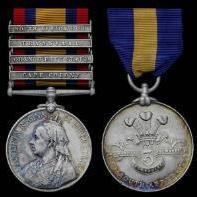
Aden Protectorate Levies
azyeoman replied to azyeoman's topic in Great Britain: Orders, Gallantry, Campaign Medals
These smaller colonial units are so very interesting and especially those from the Arabian Penninsula and Middle East. Perhaps it's because I worked there for 13 years straight, but I like the history and they're often either not considered or overlooked for the traditional British and Commonwealth units. Thanks. -
The latest Boer War PoW Medal for the collection is a singlton. QSA 1899-1902 with Cape Colony, Orange Free State, Transvall and South Africa 1901 clasps. Officially named to: 1851 Pte. J. Wheatcroft, Derby Regt. (Sherwood Foresters) who was taken prisoner of war at Roodewal also known as Rhenoster Camp on 7 June 1900. Discharge papers indicate James Wheatcroft was from ST. Mary's, Newark, Nottinghamshire and that he served until July 1901. The oil on canvas is entitled "Soldiers Defending Rhenoster Kop in the Boer War. For De Wet's account see: http://www.angloboerwar.com/books/74-de-wet-three-years-war/1527-de-wet-chapter-xiv-roodewal According to sources, On the line of communications in June 1900 there occurred several "regrettable incidents" (as the press would describe them) whereby a large bag of British POWs were taken by the Boers; who at the same time wreaked havoc upon Lord Roberts' supply line. One such incident involved the surrender on 7 June 1900, after a stiff fight and many casualties, of the 4th Militia Bn of the Derbyshire Regt. at Rhenoster Camp. Several battalions of the Militia were in SA following the national uproar over Black Week. Among other sources of manpower, nine Militia battalions were asked to volunteer for active service. The 4th Derbys was one of them and left Southampton on the transport ship "UMBRIA" on 11 January 1900 and landed at Port Elizabeth on 2 February 1900 for duties on the LofC. Some describe the action as having taken place at Roodeval (including the SAFF casualty list) wheras others correctly locate it at Rhenoster camp. Sometimes the details vary - however it is sufficient to record that DeWet's forces conducted a triple hit on the British LofC in the OFS and, in the words of Conan Doyle, at Rhenoster camp, the Derby Militia were outnumbered, out generalled and without guns. They had been tasked with guarding the supply depot on both sides of the Rhenoster river; however no entrenching was conducted. The Boers under Froneman hit the camp with concentrated rifle fire at 0200 and later employed artillery. At 1000 hrs, after suffering 156 killed and wounded, the camp surrendered and about 500 men went into captivity. The 1900 edition of Conan Doyle's work comments that "there was no shadow of stain upon the good name of the only militia battalion, which was ever seriously engaged during the war". Some opinioned that bad staff work was the root cause of the incident.
-
A nice set of insignia consisting of a cap badge with two shoulder titles and a GSM 1918-1962 with Arabian Penninsula clasp. Named to: 9368 Pte. Abdullah Saleh Saidi A.P.L. The Aden Protectorate Levies (APL) were a military force raised for the local defense of the Aden Protectorate. The Levies were drawn from all parts of the Protectorate and were armed and officered by the British military. They used the Lahaj emblem of crossed jambiyah (traditional curved double-edged dagger) as their badge. The APL were formed on 1 April 1928 primarily to protect Royal Air Force stations following the change of status of Aden to an Air Command in April 1927. Their secondary role was to be that of assisting the civil police. The APL also formed a Camel Troop. Prior to 1928 the British garrison in Aden had comprised two infantry battalions, one British and one Indian, plus Royal Artillery units and detachments of Sappers and Miners. A locally recruited infantry unit, known as the 1st Yemen Infantry, had been raised in the Aden Protectorate during 1917-18 for service in World War I but had been disbanded in 1925. Colonel M.C. Lake of the British Indian Army was the first Commanding Officer until Lt. Col. J.C. (Robby) Robinson took over command in 1929 and remained as C.O. till 1939. In 1928 the APL comprised two British officers and six platoons of Arabs (each one officer and 34 men) recruited from tribes in the Western Protectorate states, they had 48 camels and 8 mules. The APL recruited from the various tribes which lived in the foothills or the higher mountainous regions of the protectorate. During the early years of the APL's existence a number of junior commissioned officers and senior NCOs were Indian. Based in Aden Colony was the APL Depot Battalion, the Levies Base and Training Organisation. The Depot included married quarters, a neonatal clinic, a school for children, the APL Band and the APL Camel Troop. Air supply and other repair and supply units also were based there. The APL Hospital (ALH), located near Khormaksar, was a 160 bed RAF general hospital where free medical care was given to the APL's 1,500 men active members and their families, and also to former members, about 10,000 people in all. The ALH also provided the medicines to the APL. The hospital CO was an RAF doctor assisted by two RAF warrant officers, and an administration and supplies staff. Medical coverage was provided by three RAF doctors and a surgeon who were assisted by local doctors. The other RAF personnel were two male nurses, two laboratory technicians and a Pharmacist. Local people made up the rest of the staff and all of them would have been trained on site. Arab officers were called Bimbashis, with one in each battalion being responsible to the Commanding Officer for Arab Administration. They held Governor's Commissions as 2nd Lieutenant (MulazimIth Thani); Lieutenant (Mulazim Al Awal); Captain (Rais); and Major (Wakil Qaid Ith Thani). During the period of RAF control prior to 1957, a different system of Arab rank designations had been in place at all levels. The senior Arab rank was that of Lieutanant Colonel (Qaid Al Awal). During WWII the APL was expanded from 600 to 1,600 men. The Levies operated in Aden and the Western Aden Protectorate but also provided garrisons at Socotra Island and Sharjah. By 1939 an APL anti-aircraft wing had been created, which shot down an Italian plane in the course of the war. In 1942 a six year process of replacing British Army personnel serving with the APL with RAF Regiment officers and airmen commenced. This policy led to the reorganisation of the Levies into a tactical force of two wings, each about the equivalent of a battalion, plus an administrative wing. A third infantry wing was added after 1948 After the war, during the December 1947 anti-Jewish riots, some Arab personnel of the Levies proved ineffective in controlling inter-communal violence and fired indiscriminately into Jewish houses, killing several of the inhabitants. The Levies reverted to War Office control in 1957 with British Army officers and NCOs replacing RAF secondees. The AFL headquarters was at Seedaseer Lines in Khormaksar. "Up country" bases and out-stations were maintained at: Dhala, Mukeiras, Geihan, Zinjibar, Ataq and Lodar. In 1958 the APL, supported by British troops and the RAF, repulsed border intrusions by Yemeni forces in the Jebel Jihaf region. Border clashes with Yemeni tribal groups continued through the late 1950s. By 1960 the APL consisted of four rifle battalions each of which had 3" mortars, medium machine guns and signallers, and a Mechanical Transport Platoon. The APL was a brigade-equivalent force with its own air supply and air liaison officers and the Senior Arab Officer. Additional units included the APL Armoured Car Squadron, the APL Signal Squadron, the APL Band and the APL Camel Troop. The APL Camel Troop was a ceremonial unit which conducted many public appearances. On 30 November 1961, following the creation of the South Arabian Federation, the APL changed its name to the Federal Regular Army. After 1967 those British trained personnel considered politically unreliable were purged from the reorganised armed forces of the newly established People's Republic of Yemen. If interested, for another Arabian Penninsula thread to a different unit see: http://gmic.co.uk/index.php/topic/61564-trucial-oman-scouts/
-
http://gmic.co.uk/uploads/monthly_05_2014/post-7116-0-07089600-1399494689.jpghttp://gmic.co.uk/uploads/monthly_05_2014/post-7116-0-58013500-1399494738.jpgNot Australian or New Zealand, but the latest addition to this small collection of Commonwealth groups for Vietnam A rare Canadian ICSC Medal Group - The International Commission and the very rare Canadian ICSC Medal Group named - The International Commission for Supervision and Control Indo-China (ICSC) Medal (CAPT. C.R. GARSTANG), Canadian Forces Decoration QEII (CAPT. C.R. GARSTANG), and Canadian Special Service Medal, mounted as worn, missing pin, rare, extremely fine. ICSC was an interesting organization that while nominally neutral, helped the CIA in Vietnam. Listen to Blair Seaborn's (The Head of the Canadian Contingent in the ICSC) interview: http://www.cbc.ca/archives/categories/war-conflict/peacekeeping/peacekeepers-and-peacemakers-canadas-diplomatic-contribution/diplomacy-or-complicity.html For photo of then Lt. C.R. Garstang, IO go to: http://www.canadianguards.ca/Albumbc.htm and view: LtoR Capt JR White A/Coy Comd 8 Coy, Lt CR Garstang IO* and LtCol HEC Price, CO 2 Cdn Gds, at Haltern 1958. * Intelligence Officer See photo below - Garstang is in the center. London Gazette 16 October 1951 p. 5360 Territorial Army 2nd Lt. C.R. Garstang (382451) is granted the rank of Lt. 11th Feb. 1951. London Gazette Suppliment 16 October 1951 p. 5361 2nd Lt. C.R. Garstang (382451) from Active List, to be 2nd Lt. 8th May 1951, retaining his present seniority. London Gazette 27 March, 1956 p. 1804 W. Yorks. Territorial Army Reserve of Officers Lt. C.R. Garstang (382451) relinquishes his commission 24th of February 1955 on appointment to a commission in the Canadian Army. INTERNATIONAL COMMISSION FOR SUPERVISION AND CONTROL SERVICE MEDAL (ICSC) Origins: Following the end of the Second World War, instability in French Indochina (Vietnam, Laos and Cambodia grew into a full-fledged conflict as the Viet Minh waged a war of independence against French forces. In July 1954 a conference was held in, and accords were signed. Three separate commissions were established, one each for Laos, Cambodia and Vietnam. The accords further divided into two separate parts, North and South. The International Commission for Supervision and Control (ICSC) was charged with supervising the cease-fires and the with-drawl of French military personnel, facilitating the return of refugees to their homes and patriating of civilian and military prisoners. The commission was quite literally intended to supervise and control the implementation of the accords. At the direction of the commissions Indian delegation, a medal was authorized by the ICSC in February 1961, although approval from the Department of National Defence did not come until March 1962. Even then, the department was still considering whether or not to institute a Canadian General Service Medal rather than allow Canadian personnel to accept medals from international organizations. The General Service Medal project was never approved, therefore the ICSC medal was sanctioned. Criteria: Awarded for ninety days service consecutive or cumulative as a member of the Commission between 7 August 1954 and 28 January 1973. Persons killed while serving with the commission were automatically awarded the medal posthumously. Medal: A circular antiqued bronze medal, 34mm in diameter, bearing the crossed flags of Canada and Poland, with the arms of India in the center and the dove of peace at the point where the flags cross, circumscribed by the words International Commission for Supervision and Control, with the word Peace at the base. The reverse bears a map of Indochina with the names of the three countries Vietnam, Laos and Cambodia. Suspender: A floral motif connects the mounting suspender to the medal: the suspender through which the ribbon passes appears to be shoots of bamboo. Ribbon: A 32mm wide ribbon of three equal stripes: dark green, white and red. The green represents India, the white peace and the red Canada and Poland. Bars: None Other: The medal was made by Bartons Jewelers of Bangalore, India. The recipients name and rank were impressed on the rim in block capitals, and the impression was then filled in with white paint. This award was superseded by the ICCS Medal. Number of Awards: 1,550 in total with Canada getting around 300 plus. The exact numbers available are conflicting and as of now are not verifiable. According to Guy Paquette in his Reunification of Vietnam: The Canadian Connection The French military defeat at Dien Bien Phu swiftly lead to negotiations and from May to July, 1954, a conference was convened in Geneva, Switzerland, to resolve the problems within Indo-China; specifically Vietnam, Cambodia and Laos. The Geneva Accords was drafted and provided for Vietnams return to independence - but, not before free elections were scheduled for July of 1956. Until then, Vietnam was temporarily divided into two states to enable the separation of the opposing parties. The Communists were to go to the north of the 17th parallel while others were to withdraw to the south. A three-nation observer force was installed under the auspices of the Geneva agreement. Canada, Poland and Indian made up the International Commission for Supervision and Control (ICSC). This non-United Nations (UN) force consisted, respectively, of western, communist, and neutral administrators and military personnel. It was an unexpected and unique invitation for Canada that saw members of External Affairs and the military on a mission together. In short order, 133 Canadians were dispatched to locations throughout Indo-China during the fall of 1954. The ICSC mission was to ensure that the cease-fire was obeyed, that military forces and refugees returned to their areas and that cross-border movement of unauthorized military personnel and war materiel was controlled throughout Cambodia, Laos and Vietnam. As part of the Agreement, the international observers were to monitor the elections that would determine Vietnams future as a nation. The members of the Canadian Delegation were witnesses to history from the onset. The former Viet Mihn alliance crumbled as Ho Chi Minh and his communist allies seized power in the north while Emperor Bao Dais nationalists were left to administer the south. However, it didnt take long for Bao Dai to be flushed out of the scene as the USA intensified its involvement in the politics and warfare of Southeast Asia. In October of 1955, the anti-communist, U.S. backed, Ngo Dinh Diem declared the south as the Republic of Vietnam and announced himself as its president. The promised elections that Canadians were to observe never transpired. Ngo Dinh Diem continued to squash any talk of elections by refusing to negotiate with the North all the while suppressing any opposition to his rule. His defiance spoiled the hope of reunification and this lead to the Second Indochina War, better known as the Vietnam War of the 1960s. Canadians left in 1959 but rejoined the ICSC in the 1960s. In 1965, two Canadian soldiers were killed during the observer mission as Vietnam was engulfed in war between communist and democratic powers. The UN finally pulled the ICSC out of Southeast Asia as the war peaked in 1969. Vietnam, the former colony, would not be a nation again until the north and the south were united - and - the communists had plans for that eventuality. The Canadian connection to Vietnam continued as a result of the January 1973 peace talks between the USA, the Vietcong, North Vietnam and South Vietnam. Canada returned to the embattled area to monitor peace under the United Nations new International Commission of Control and Supervision (ICCS). However, the political divisions ran too deep and the desire to be one country was too strong. In 1975, a well-coordinated invasion of the south by communist forces sealed Vietnams fate. The former colony was reunified and once again a nation.
-
Another Boer War pair for the collection: Queen's South Africa Medal (Bar - Transvaal) named to 4570 Corpl: J. Martin. Rl: Lanc: Regt. King's South Africa Medal (Bars - South Africa 1901 and South Africa 1902) named to 4570 Pte. J. Martin. Rl: Lanc: Regt. Joseph Henry Martin was born in Buxton, Derbyshire. Before the Boer War, he had joined the militia in 1894 and made a career of the army as he was already in the regiment and served in Singapore with the 1st Bn. from 17 January 1899 to 26 March 1900. The single clasp "Transvaal" suggests that Martin was with the replacements after the disaster at Spioenkop on 24 January 1900. QSA is not listed because his page (WO 100/168 p88) is missing, but KSA is listed on WO100/320 p54. Cpl. Martin was taken prisoner at Vryheid on 11/12/1900 and was released on 04/01/1901. The 2nd Bn. served in South Africa from December 1899 to May 1902 and had heavy casualties with 139 men killed or died of wounds, 40 died of disease, 258 wounded and 67 taken prisoner. In October 1900 the unit became the garrison at Vryheid with a strength of about 900. It was based at Lancaster Hill. On 11/12/1901, at about 2am, 1,200 Boers attacked the hill from the north. The defenders fought hard but were nearly overwhelmed and when Lt/Col. Gawne led reinforcements out of the town he was mortally wounded. The Boer advance was eventually stopped by heavy defensive fire and the barbed wire at the top of the hill. The Military History Journal, Vol. 10 No. 4 (December 1996) contains an excellent article by Mark Coghlan titled “The Transvaal Outbreak : The Boer attack on Lancaster Hill, Vryheid, 11 December 1900”. This can be downloaded from the Internet. It is well illustrated with a map and contemporary photos (see below) and covers the action extremely well. It highlights the unequal outcome of the skirmish in terms of casualties; all indications are that the Boer Commando’s had only two men killed. There is no mention of the number of Boers wounded and/or taken PoW. The photo is of the maxim gun emplacement on Lancaster Hill.
-

A small Korean War Collection
azyeoman replied to azyeoman's topic in Modern Campaigns and Conflicts
Thank you. There's an updated version of it here: http://gmic.co.uk/index.php/topic/56543-the-korean-war-is-not-forgotten/ Hopefully you'll see some interesting things there. All the best, -
The latest addition is a WWI RAF PoW pair with IGS; sadly missing its Victory Medal (Please contact if you know of its whereabouts). Both named to: British War Medal 2.LIEUT. E.C. USHER-SOMERS, R.A.F. India General Service Medal bar Waziristan 1919-21 F/O E.C. USHER-SOMERS, R.A.F. Pilot, 46 Sqd. (Camels) P.O.W. 17.9.1918. Shot down by ace Josef Mai* (Pour le Merite winner, but never awarded his PLM due to the war ending) 26th of 30 Victories. Copy I.G.S. roll, 20 Sqd. The Sky Their Battlefield 17.9.1918 (Black September) seen in combat Missing P.O.W. Bloody AprilBlack September page 189 Lieut. C.E. Usher-Summers confirming he was Mais 26th Victory. Continued service in the R.A.F. & was killed 16.5.1924 in service. Edmund Cronin Usher-Summers was born on 28 January, 1900. Before entering the RNAS, he served as a Lance Corporal in the 2nd Hants. Regt. from 3.1917 to 20.7.1917. He was posted to Greenich on 30.10.1917 and then Eastbourne on 8.2.1918 as Temporary Pro Flight Officer. He was appointed 2nd Lt. In the newly formed RAF in April, 1918 served in 20 Sqd., 2 Indian Wing in Waziristan Operations in 1919-1921. He was promoted to Flying Officer (Observer) in September, 1920. He had been recommended by N. L. Christantian, Principal of St. John's College, Southsea. His mother was listed as his next of kin; Mrs. Florance Usher-Somers C/O Mrs. Edleroake, Westhill Postishead, Somerset. No. 46 Squadron was formed at the RAF Wyton aerodrome on 19 April 1916 from a nucleus trained in the No. 2 Reserve Squadron; it moved to France in October of that year equipped with Nieuport two-seater aircraft. The squadron undertook artillery co-operation, photography, and reconnaissance operations until May 1917, when it took on a more offensive role after rearming with the Sopwith Pup. The change from a corps to a fighter squadron came at a moment when Allied air superiority was being seriously challenged by Germany, in particular through the introduction of the "circuses" formed and led by Manfred von Richtofen. Operating under the 11th Army Wing, the squadron was intensively engaged and had many combats with the enemy. In July 1917, No. 46 Squadron returned to Sutton's Farm (later RAF Hornchurch), Essex, for the defence of London, which had been heavily raided by Gotha bombers a short time before; no enemy aircraft penetrated its patrol area The squadron returned to France at the end of August. In addition to offensive patrol work, the unit undertook extensive ground strafing and did close support work in the attack on Messines Ridge. In November 1917, the squadron was newly equipped with Sopwith Camels and gave valuable assistance to the infantry in the Battle of Cambrai attack. During the closing stages of the war, the squadron bombed lines of communication and ammunition dumps in the enemy's rear areas. Intensive low-level ground attack work was carried out after the German Spring Offensive in March 1918, the unit suffering high casualties as a result. The squadron also did work in the German Great Retreat in the few weeks before the signing of the Armistice. In November 1917, Lieutenant (later Major) Donal MacLaren joined the squadron. His first dogfight was not until February 1918; in the remaining nine months of the war, however, he was credited with shooting down 48 aeroplanes and six balloons, making him one of the top fighter aces of World War I. Also during 1918 Lieutenant Victor Yeates, the author of Winged Victory, served in the squadron. Another book written by a 46 Squadron pilot was No Parachute by Captain (later Air Vice Marshall) Arthur Gould Lee. Both Lee and Yeates served with Captain Cecil (Chaps) Marchant, another ace, who instigated and, for more than 40 years, organised the squadron reunions. By November 1918, 46 Squadron had claimed 184 air victories, creating 16 or 17 aces. Other notable aces in the squadron included: George Thomson, DSO, MC, DFC; Harry Robinson, MC; CdG; Clive Brewster-Joske, MC; Roy McConnell, DFC; Maurice D.G. Scotts, MC; Maurice Freehill, DFC; and Philip Tudhope, DFC. Towards the end of January 1919, the squadron was reduced to a cadre, and in February it was returned to England early; it was disbanded on 31 December. *Major Josef Mai (3 March 1887 - 18 January 1982) Iron Cross First and Second Class, was a World War I fighter pilot credited with 30 victories. Josef Mai was born in Ottorowo, Galizien, to ethnic German parents located in the then Austro-Hungarian Empire. His original military service began on 3 October 1907 with the 10th Lancers. When World War I began Mai was part of the offensive aimed at the French capital of Paris. He later took part in the fighting around Warsaw, Poland. In 1915 he campaigned along the Dniester River. He also served at the battles of Verdun and the Somme. Mai joined the German air service in 1915; he trained at the Fokker plant at Leipzig. He originally served in Jasta 29, flying reconnaissance aircraft in 1916. He then underwent fighter training and joined Jagdstaffel 5 in March 1917. As a Vizefeldwebel (Vice Feldwebel, senior NCO), he was one of three non-commissioned pilots (along with Fritz Rumey and Otto Koennecke) who flew together so successfully they ended up claiming 40% of the Jasta's victories between them, and making Jasta 5 the third highest scoring unit of the war. The trio was nicknamed "The Golden Triumvirate". Mai scored his first victory on 20 August 1917, flying an Albatros D.V, and downing a Sopwith Camel of No. 70 Squadron. His fifth victory, over a RAF SE.5a, was on 30 November. Mai did not score again until 13 January 1918. On 25 April 1918 he forced down British 18-kill ace Lt. Maurice Newnham of No. 65 Squadron, for his tenth victory. By May 1918 Jasta 5 was sharing an airstrip with Jagdgeschwader 1, and as the Flying Circus re-equipped with new Fokker D.VIIs, Mai started flying a cast-off Fokker Dr.I triplane. He flew this triplane (Serial No. 139/17) for his next victory, over a pair of aces in a No. 11 Squadron Bristol F.2B Pilot Lt. Herbdrt Sellars (8 claims) was killed although Observer Lt. Charles Robson survived and taken prisoner. He claimed three victories with the Triplane. Mai was prone to paint his planes in a "zebra stripe" pattern,with black and white striping on the fuselage angled to the left viewed from the starboard side. His theory being the optical illusion would help to throw off an enemy pilot's aim. Painted on this background was his insignia of a star and crescent. His Albatros and D.VII were known to bear this paint scheme although his Dr.l paint scheme is uncertain. On 19 August 1918 he had his most successful day. He attacked two Bristol F.2B fighters from No. 48 Squadron, RAF. As he hit one Bristol with incendiary ammunition, the other swerved away from the incoming fire and collided with his wrecked companion. Mai followed up this double kill by downing a 56 Squadron SE.5a later. On 3 September he was wounded in action in the left thigh. Nevertheless he scored again two days later, and added five more victories during September. Mai's 26th victory was a No. 64 Squadron SE5a on 5 September 1918 in which Usher-Somers was shot down and captured. On 27 September 1918, the day of his 29th success, Mai was promoted to Leutnant. His friend Fritz Rumey was also killed in action on that day. Mai claimed his 30th and last score, a Bristol F.2B of 20 Squadron, killing the 6-kill ace crew of Lt. Nicholson Boulton and 2/Lt. C.H. Chase on 29 September 1918.15 had been claimed with the Fokker D.VII, 12 with the Albatros and 3 with the Fokker Dr.I. Mai was nominated for Germany's highest honor, the Pour le Merite, or Blue Max. Before it could be approved the war ended with Germany's loss. Mai is believed to have become a flying instructor for the Luftwaffe during World War II. He died at the age of 94 in January 1982.
-

Indian Army Victory Medals
azyeoman replied to IrishGunner's topic in Inter-Allied Victory Medals of the Great War
Very nice, but different units to The Indo-European Telegraph Dept. I have a pair to a R. Wilcock and his MIC says he was a signaller and later a Sargeant. I wish I knew more as the line, which ran through Persia, was shut down soon after the war started. -

Indian Army Victory Medals
azyeoman replied to IrishGunner's topic in Inter-Allied Victory Medals of the Great War
I.E. Tel. Dept. Is Indo-European Telegraph Department and NOT Indian Engineers Telegraph Dept. It's a very scarce to rare unit that worked in what is now Iran.

